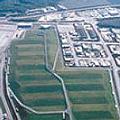 諾曼地驚傳輻射外洩。法國位於埃魯維爾聖克萊爾(Hérouville St Clair)的ACRO實驗室發布一份新報告指出,諾曼地一座中低階核廢儲存場芒什處置場(Centre Stockage de la Manche,簡稱CSM),存放於該處放射性氚滲入地下水,污染了地方酪農仰賴的水源。
諾曼地驚傳輻射外洩。法國位於埃魯維爾聖克萊爾(Hérouville St Clair)的ACRO實驗室發布一份新報告指出,諾曼地一座中低階核廢儲存場芒什處置場(Centre Stockage de la Manche,簡稱CSM),存放於該處放射性氚滲入地下水,污染了地方酪農仰賴的水源。
ACRO實驗室主任波以禮(David Boiley)博士表示:「芒什處置場的管理不善傷害了環境。幾次意外已造成輻射持續外洩污染,地下水和多處出水口均受到了氚的高度污染。」
芒什處置場位於諾曼第科坦丁(Cotentin)半島西部頂端處,由阿雷瓦核廢料回收公司(Areva Nuclear Cycle,,Areva NC)經營。該公司在此將用過的核子反應爐燃料再加工,做成可再次使用的鈾和鈽燃料。
ACRO發現在地下水層的放射性強度平均達到750Bq/l,比歐洲合法安全值所限制的100Bq/l高出7倍之多。ACRO的測試也發現2005年時,靠近核廢場的農地地下水層的放射性強度平均達到9000Bq/l——比安全限制值高出90倍之多。
波以禮警告:「就未來的情形而言,長久下來情況會越來越糟,因為目前無法保證用來儲存舊廢料的封存設備能夠撐多久,況且其中還封存了更多危險物質,等到偵測到新污染時,一切都太遲了。」
綠色和平組織核子議題專員伯尼(Shaun Burnie)表示:「30多年前,當局信誓旦旦向法國大眾保證,關於芒什處置場地點的選擇是根據地質學和水文學等廣泛評估所做出的決定,而且不會有任何污染的危險。但是事實上,輻射污染的強度已經比自然輻射強度高出幾千倍了。」
Radioactive tritium from a nuclear waste storage facility in Normandy, France is leaking into groundwater that is being used by local farmers for their dairy cattle, according to a new report published by the French laboratory ACRO.
Contamination from the low and intermediate level nuclear waste disposal facility at la Hague, the Centre Stockage de la Manche (CSM), migrates from the dumpsite into the underground aquifers used by farmers, the Hérouville St Clair-based laboratory found.
"Because of its mismanagement, CSM is causing damage to the environment," said ACRO Director Dr. David Boiley. "Repeated incidents have led to a constant release, and as a consequence the ground water and many outlets are highly contaminated with tritium."
Located on the western tip of the Cotentin Peninsula in Normandy, the Areva NC La Hague site reprocesses spent nuclear power reactor fuel into reusable uranium and plutonium.
ACRO found that levels of radioactivity in the aquifer are on average 750 Bequerels per liter (Bq/l), - more than seven times the legal European safety limit of 100 Bq/l. In agricultural land close to the dumpsite, ACRO tests found levels in the underground aquifer during 2005 averaged 9000 Bq/l - 90 times above the safety limit.
"As far as the future situation," Boiley warned, "it could worsen in the long run because there is no guarantee that the wrappings of the older wastes, which also contain more hazardous elements, will last for long periods of time. When a new contamination is detected it will be too late."
"More than 30 years ago the French public were assured that selection of the CSM dumpsite was based upon extensive assessments of the geology and hydrology, and that there was no risk of contamination," said Shaun Burnie Greenpeace nuclear campaigner. "In reality," he said, "levels have reached thousands of times the natural background level."



